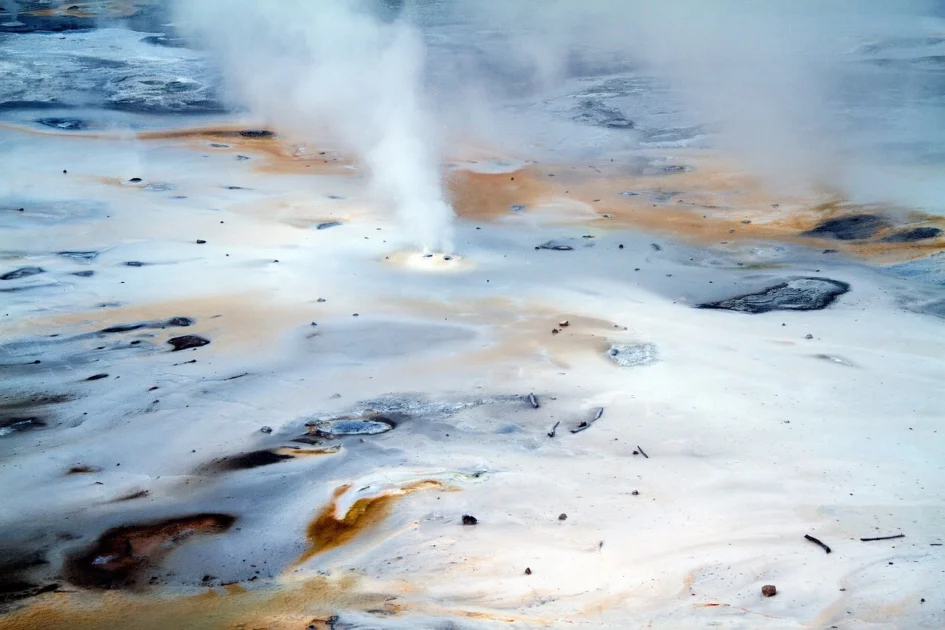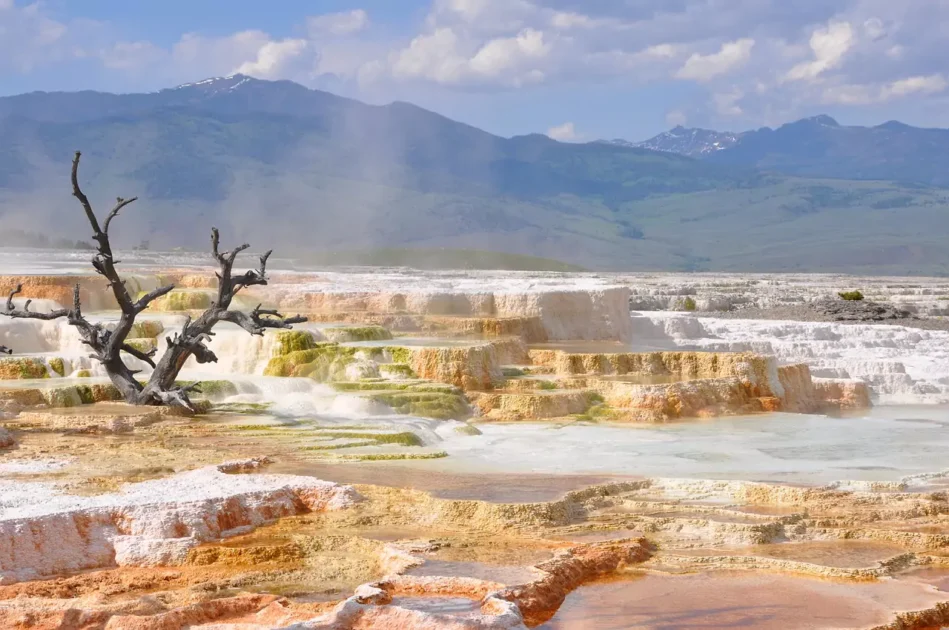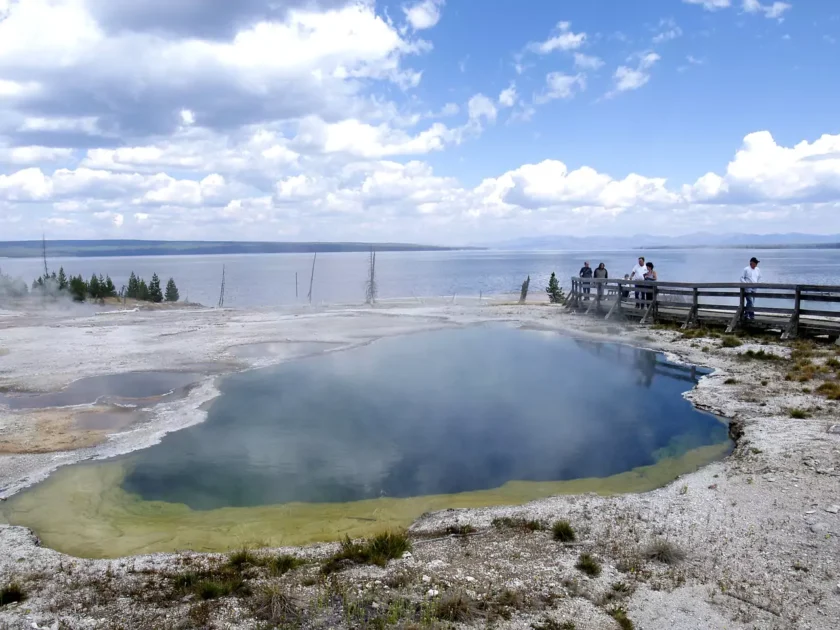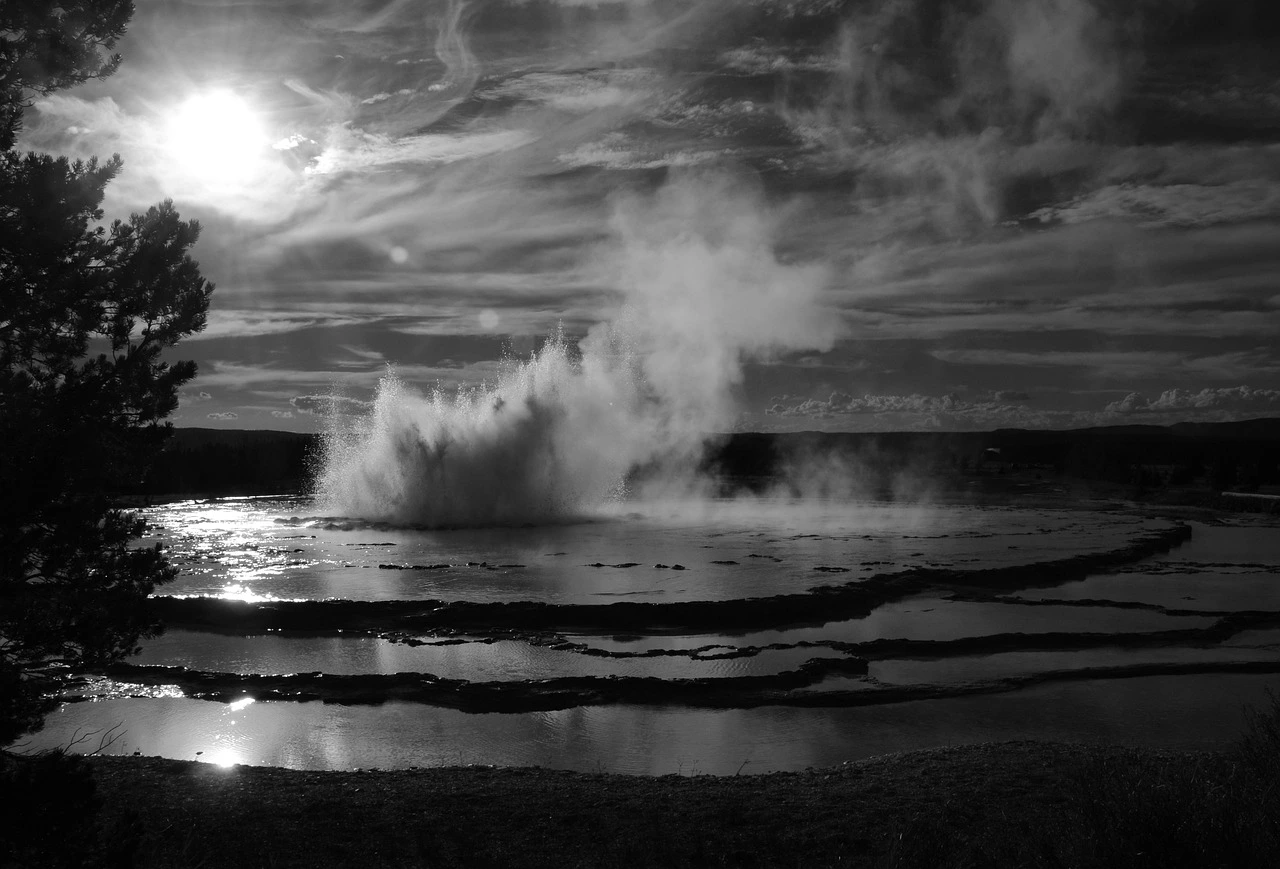Discover the Roaring mountain Yellowstone National Park: A Journey to the Top
Introduction
Did you know the Roaring Mountain in Yellowstone National Park has more than 200 active geysers and many hot springs? It’s cool to see all the steam vents and fumaroles; they make the place look so different. I learned this mountain has some remarkable rocks and stuff underneath it; it’s pretty powerful!
Let’s visit the impressive Roaring Mountain in Yellowstone National Park. It’s like entering a surreal world where you can feel the power of nature all around you. We’ll discover its secrets, learn how it was formed, and understand why it’s crucial to this famous national park in America.

Geological Significance of Roaring Mountain
Unique Hydrothermal Feature
Roaring Mountain is an excellent place in Yellowstone Park. It’s famous for the hot water and steam that comes out of it. It’s in Norris Geyser Basin. The heat from underground rocks makes the water hot, creating steam and gas.
Roaring Mountain is unique because of its active hydrothermal system. This system has hot springs, steam vents called fumaroles, mud pots, and geysers.
These things happen when water goes into the ground through cracks and then gets heated up by magma underneath. Because of this, steam and gas constantly emerge from these hydrothermal features.
Norris Geyser Basin
The Norris Geyser Basin in Yellowstone is excellent, with lots of hot stuff. Some geysers shoot up water, colorful hot springs because of tiny organisms, smelly gas from holes called fumaroles, and bubbling mud pots. All of these things happen because of volcanoes deep underground.
One interesting fact about Norris Geyser Basin is that it has two main sections: a Porcelain Basin on its western side, known for its porcelain-like appearance due to sinter deposits.

The Fumaroles of Yellowstone’s Roaring Mountain
Geothermal Activity
Roaring Mountain in Yellowstone National Park is a fantastic place with geothermal activity. It has lots of fumaroles, which are also called steam vents. These vents release hot gases like carbon dioxide and sulfur dioxide, making Yellowstone’s geothermal activity impressive.
When you walk on the boardwalk near Roaring Mountain, you can feel the ground shaking from the power of these strong vents.
The park rangers say to stay on the paths because it’s hot and the ground is shaky from the fumaroles. This keeps us safe and helps the plants and animals, too. The steam vents are cool to see, hear, and smell.
Unique Features
Roaring Mountain got its name because it makes a loud noise. You can hear a rumbling sound from deep inside the Earth when you stand near it. It sounds like faraway thunder or a storm getting closer.
This is why it’s called “Roaring.” This makes Roaring Mountain unique and exciting for Yellowstone National Park people. The noise differs from other places in the park, making it even more exciting for visitors.
When I was there, I saw steam rising into the air and felt the ground shaking. It made me think about how unique nature is. It made me feel small and amazed at the power of our planet.

Norris Geyser Basin and Roaring Mountain
Norris Geyser Basin: A Unique Thermal Area
Roaring Mountain is found in Norris Geyser Basin, an excellent place in Yellowstone National Park. It has many different hot things like geysers, hot springs, and mud pots. The basin constantly changes and has many pretty colors, so it’s one of the best things to see in the park.
You’ll see lots of exciting stuff when you visit Norris Geyser Basin. There are steamy fumaroles that let out smelly gases and hot springs that have tiny living things in them.
The landscape is weird and different, with bright colors from the living things and empty land. I think it’s incredible how nature made such a crazy place like Norris Geyser Basin. It’s constantly changing and shows us how powerful the Earth can be.

Roaring Mountain: A Spectacular Display
Roaring Mountain in Norris Geyser Basin is a sight to behold. It gets its name from the steam from many vents on the mountainside. These vents make a loud, roaring sound, making the experience even more exciting.
When I visited Roaring Mountain, I couldn’t help but be amazed by its raw power and natural beauty. It’s incredible how this wonder of nature captures visitors’ attention with its stunning visuals and impressive sounds.
Accessibility and Visitor Experience at Roaring Mountain
Easy Access
Roaring Mountain is easy to reach by car or on foot using Norris-Canyon Road in Yellowstone National Park. You can park your car nearby and see the cool roaring fumaroles without hiking far.
Last summer, my family drove down Norris-Canyon Road and found a parking area by Roaring Mountain. We walked a short distance to see the fumaroles up close. It was excellent, and we felt safe, too.
Observation Without Trails
Roaring Mountain has no specific paths, but you can still see amazing views from a safe distance. This means anyone, even if they have trouble walking or are young, can enjoy this incredible natural wonder without going on rugged trails.
Not having paths makes it more fun because you can explore and look at nature at your own speed. When we saw Roaring Mountain, it was so cool! I felt lucky to see such beautiful nature up close. And the best part was that anyone could see it without walking far!
Thermal Wonders of Yellowstone’s Geysers and Hot Springs
Awe-Inspiring Geysers
Yellowstone National Park is famous for its roaring mountain and lots of geysers, like the cool Old Faithful. There are over 10,000 hot water features, with boiling water and erupting geysers that are super cool.
The park has a lot of different landscapes, so it’s an excellent place to watch these amazing things happen. Geysers erupting are incredible to see. Picture yourself standing next to a hot pool of water, and then suddenly, it shoots up into the sky!
It’s not just pretty; it also reminds us how powerful the Earth is. Seeing these things in person is exciting, and you can learn a lot. You know how the Earth works and how incredible nature is.
Colorful Hot Springs
Yellowstone has pretty pools of hot water that come in many different colors. They look fantastic against the rough land. The colors come from tiny organisms that like the heat and live there.
People can see these colorful pools up close on safe boardwalks. It’s a great way to explore without hurting the environment. Walking next to these pretty pools feels like part of nature’s art. Note: I loved how everything felt so alive when I went to Yellowstone with my family last summer.

Insider Tips
Early Wake-Up for the Show:
If you want to see Roaring Mountain at its best, come early in the morning. When the sun wakes up, you’ll see steam rising from the ground. It’s like nature’s own magic show! Come early to enjoy the quiet time before everyone else arrives.
Pack Your Nose:
Yellowstone is a super cool place for your senses, and Roaring Mountain is no different. Bring your nose because there’s a special smell here – like the Earth’s own perfume! Embrace it, it’s part of the adventure.
Time Matters:
Roaring Mountain follows its own schedule. Plan to visit in the morning or late afternoon when it’s not too hot. The changing temperatures make Roaring Mountain even more exciting – a real treat for all explorers.
Record the Sounds:
Roaring Mountain isn’t just pretty; it makes cool sounds too. Bring a good microphone or recorder to catch the hissing and bubbling noises. Your memories will love the sound effects!
Respect the Roar:
It’s tempting to get close, but be safe. The steam is powerful, so stay back and enjoy the view from safe spots. Mother Nature likes visitors who follow the rules!
Find the Hidden Paths:
Take a walk on the trails around Roaring Mountain. Sometimes, the best views are away from the big crowds. Put on your hiking shoes and explore the quiet spots for a special connection with this cool place.
Dress Right:
Yellowstone’s weather can be tricky, so wear layers. Whether it’s chilly in the morning or warm in the afternoon, being ready means you can enjoy Roaring Mountain without worrying about the weather.
Safety Precautions
When you go to Yellowstone National Park, following the safety rules around places like Roaring Mountain is essential. Stay on the paths and boardwalks because going off them can be dangerous with hot water and unstable ground.
Also, stay far away from the geothermal stuff because you never know what might happen. When you walk around Roaring Mountain, wearing good shoes with good grip is super important because the ground is bumpy, and steam might be covering the paths. And remember to bring lots of water and drink it so you don’t get too hot near the geothermal stuff.

Activities at Roaring Mountain Yellowstone National Park,
- Look at the Hot Springs: Take a walk around Roaring Mountain and see the hot springs. They bubble and are colorful – like a natural hot spring art show!
- Picnic Time: Bring some food and have a picnic near Roaring Mountain. Eat while watching the steam – it’s like having lunch with nature’s music. And, of course, take lots of pictures!
- Find Wildlife Friends: Yellowstone has lots of cool animals. Keep your eyes open for bison, elk, or even a coyote near Roaring Mountain. The hills and meadows are great spots to see these amazing creatures.
- Take Pictures Everywhere: Use your camera to capture Roaring Mountain’s beauty. The changing light and steam make for amazing photos. Try different angles and settings to tell a visual story of this cool place.
- Listen to Ranger Stories: Park rangers tell interesting stories. Check if there’s a talk near Roaring Mountain. Learn about rocks, nature, and how to take care of the park. It makes your visit even more interesting.
- Go for a Nature Walk: Wear your comfy shoes and explore the nearby trails. There are easy walks and more challenging hikes. You can choose what you like!
- Relax in Boiling River: After a day of fun, chill in Boiling River. It’s a mix of hot spring and river water. Super relaxing with the sounds of nature around you.
- Sleep Under the Stars: If you’re up for it, camp in Yellowstone. Sleep under the stars and listen to Roaring Mountain from your tent. It’s like a sleepover with nature!

Nearby Attractions
Awesome Places Around Roaring Mountain!
Norris Geyser Basin:
- A short drive away.
- Hottest and oldest thermal area.
- Colorful hot springs, geysers, and the super tall Steamboat Geyser.
Mammoth Hot Springs:
- Go north to Mammoth Hot Springs.
- Terraces made by flowing water.
- Great for photos and special views of Yellowstone’s hot wonders.
Grand Canyon of the Yellowstone:
- South of Roaring Mountain.
- Lower Falls and colorful canyon walls.
- Trails for walking and amazing views of nature’s art.
Yellowstone Lake:
- Biggest high-altitude lake.
- Relax by the lake, take a boat tour, or enjoy the calm vibes.

Artist Point:
- South rim of the Grand Canyon.
- Famous for wide views.
- See the canyon and Lower Falls – a must-visit spot.
Old Faithful:
- Go to Old Faithful, the famous geyser.
- It shoots water high during eruptions.
- Surrounded by other geysers and hot springs.
Yellowstone Wildlife:
- Look out for animals in Hayden Valley, Lamar Valley, and Tower-Roosevelt.
- Bison, elk, wolves, and bears live here in their homes.
West Thumb Geyser Basin:
- Mix of geothermal features and lake views.
- Walk on boardwalks by Yellowstone Lake.
- Hot springs bubble by the lakeside – a cool experience.
Market and Local Delights
Exploring the Market
When you go to roaring mountain yellowstone national park , you can do more than just see cool stuff. There’s also a fun market nearby where you can buy extraordinary things made by locals. They have cool crafts and souvenirs you won’t find anywhere else. You can also try yummy snacks and drinks from the area to learn about their culture.
Tasting Local Delights
You can enjoy yummy local treats when you visit Roaring Mountain in Yellowstone National Park. Many tasty options include fresh pastries, different kinds of honey, and homemade jams. You can also find handmade things, like woven fabric and pretty pottery, that show off the area’s culture.
Sampling these local delights not only tantalizes your taste buds but also allows you to connect with the community and gain insight into their traditions. It’s an immersive experience that adds depth and authenticity to your visit.

Best Time to Visit Roaring Mountain:
Late Spring to Early Fall (May to September)
Late Spring Magic:
May to see the park waking up after winter.
Flowers start blooming, and nature gets lively.
Sunny Summer Days:
June to September is warmer.
Perfect for exploring without freezing.
Fantastic Fall Colors:
Fall, from late September, brings colorful leaves.
Adds extra beauty to your visit.
Why Visit in These Seasons
Weather is comfy.
Nature is at its best with flowers, warmth, and fall foliage.
Check the Weather:
Conditions can change, so always look at the weather before planning.
So, Plan Your Visit from May to September:
Pick a time in these months, and Roaring Mountain will welcome you with its best natural wonders. Enjoy your trip!
Closing Thoughts
Roaring Mountain in Yellowstone Park is an amazing place to visit. It has powerful fumaroles and is important geologically. It’s easy to get to, and we have tips to make your visit safe and fun.
Make sure you plan a trip to Roaring Mountain! You’ll get to see unique thermal features and do excellent activities. It’s perfect for nature lovers, science nerds, or anyone who wants an adventure. Take advantage of the chance to see the incredible power of Earth’s geothermal wonders at Roaring Mountain!
Frequently Asked Questions
Q: What is the geological significance of Roaring Mountain?
A: Roaring Mountain’s geological significance lies in its active fumaroles, which release steam and gases. These features indicate the presence of a geothermal system beneath the mountain, contributing to Yellowstone’s unique landscape.
Q: How can visitors access Roaring Mountain, and what is the visitor experience like?
A: Visitors can access Roaring Mountain via a scenic drive or guided tours. The area offers an immersive experience with opportunities to witness potent thermal activity up close, providing a captivating glimpse into nature’s forces at work.
Q: What are some activities available at Roaring Mountain Yellowstone National Park ?
A: At Roaring Mountain, visitors can enjoy observing the impressive fumaroles and experiencing the raw power of nature firsthand. Educational walks and photography opportunities deepen my appreciation of this natural wonder.
Q: When is the best time to visit Roaring Mountain?
A: The best time to visit Roaring Mountain is during late spring through early fall when road access is optimal. This period ensures favorable weather conditions for exploring and appreciating the thermal wonders without extreme temperatures affecting your experience.
Q: Are there any nearby attractions worth visiting around Roaring Mountain?
A: Norris Geyser Basin near Roaring Mountain offers additional geothermal marvels such as colorful hot springs and bubbling mud pots. Exploring these nearby attractions enhances your overall Yellowstone National Park adventure.
Q: Where is Roaring Mountain?
A: Roaring Mountain is in Yellowstone National Park, USA. It’s known for steam and noise, like a faraway waterfall.
Q: Why is Yellowstone National Park famous?
A: Yellowstone National Park is well-known for its beautiful hot springs, like Old Faithful, and a variety of animals, such as bears and wolves. People from all over the world come to see the park’s special scenery and amazing natural sights.
Q: What is the tallest mountain in Yellowstone National Park?
A: The tallest mountain in Yellowstone National Park is Eagle Peak, reaching a height of 11,358 feet (3,462 meters) above the sea. It provides stunning views and is a popular spot for people who enjoy hiking.
Q: Where is Yellowstone mountains located?
A: Roaring Mountain Yellowstone National Park, where the Yellowstone mountains are found, is mostly in the U.S. states of Wyoming, Montana, and Idaho. The park covers these states and displays many different landscapes, hot springs, and animals.

